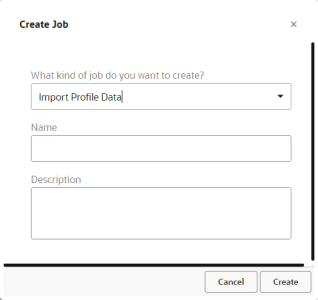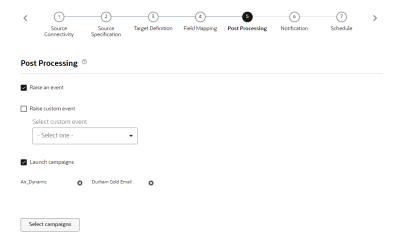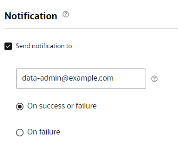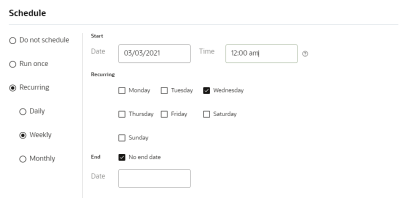Importing ORCE Data
Important: This topic is for users of the latest version of Connect . If your account still uses Classic Connect, download the Classic Connect User Guide.
Oracle Retail Customer Engagement (ORCE) customers can import the following data from ORCE into an existing profile extension table in Oracle Responsys:
- ORCE Loyalty Program
- ORCE Customer Attributes
- ORCE Stratified Segments
Important: This feature is available only if it is enabled for your account.
After an import job runs, the upload file is archived on the server. If the job is successful, the upload file is deleted. If the job fails, the upload file is deleted only in the following circumstances:
- The file is empty
- The file has data issues, such as invalid data format
- The upload file and the count file have different number of records.
Before you begin:
- Make sure the PET for importing data exists. You cannot create a PET while configuring the job.
- Your account administrator must configure the settings for ORCE import jobs using the Account management page.
To create an ORCE import job:
- Click
 Data on the side navigation bar, and select Connect.
Data on the side navigation bar, and select Connect. - Click Create Job on the Manage Connect page.
- Select Import Profile Data from the drop-down list and provide a name and description of the import job.
A job name cannot be longer than 100 characters and can include only the following characters: A-Z a-z 0-9 space ! - = @ _ [ ] { }
- Click Done.
The Connect export wizard opens. You may complete the steps in any order, and can save your changes and continue at a later time.
- Complete the steps:
- After you configure all the steps, click Save. To save and activate the job, click Activate.
Important: Before you can save or activate the job, you must either set an expiration date, or set the job to never expire. To set an expiration date, click Edit![]() next to Expiration. When the job expires, it is deleted and cannot be recovered. Learn more about managing the expiration date.
next to Expiration. When the job expires, it is deleted and cannot be recovered. Learn more about managing the expiration date.
After you finish:
- After you save your job, you can use the Manage Connect page to manage the job. Learn more about managing jobs.
- When you save your job, Connect may return errors. Click Show Errors to review the errors and quickly jump to the page that needs fixing. You must resolve all errors before you can activate the job.
Step 1: Target definition
In this step, you select the profile extension into which to import data.
To add a target definition:
- On the Target Definition step, select the list corresponding to the target profile extension table.
- Select the Target Profile Extension from the drop-down list.
- To replace the existing table records with the newly uploaded records, select the Remove all existing records from target table and then insert new records checkbox.
Step 2: Field mapping
In this step, you map columns from the source file to fields in the target profile list or PET. Mapping fields specifies which column corresponds to which field.
You can manually map the fields or use an upload file for the mapping.
Note the following:
- Long field names are truncated to 30 characters.
- Field names must begin with a letter or number and may contain only letters, digits, and _ (underscore).
- When created, field names are not case-sensitive, but are later translated to all uppercase.
- If any changes result in duplicate field names, you will need to manually rename them.
- All system field names (defined and reserved by Oracle Responsys) end with an underscore character, for example EMAIL_ADDRESS_. As a best practice, uploaded field names should not end with an underscore character since these are reserved for system fields.
- When possible, match like-named incoming fields with existing fields, for example, match CUST_ID to CUSTOMER_ID_.
For more details about data type and field name requirements, see Data Types and Field Names.
To upload a mapping file:
- On the Field Mapping step, click Upload File.
- Select the mapping file and complete the details.
- Fields are delimited by: Select the delimiter (typically a tab or comma) that divides the columns in the file.
- Fields are enclosed by: Specify whether text columns and values are enclosed in single or double quotation marks.
- First line contains column names: Select this checkbox if the first line contains field names.
To map fields manually:
- On the Field Mapping step, click Add +.
- Type the name of the incoming field in the space provided.
- Select the target destination for that field.
- Select the matching field name in the target. If you do not want to match a field, select skip this field.
- Click Update.
Step 3: Post processing
In this step, you select the actions to take after a successful job run.
- Raise an event: Select this checkbox to make the completed job available to Program. If selected, the job will be available as a Connect event in Program.
- Raise custom event Select this checkbox to raise the specified custom event after the job completes successfully. You select the event to raise from the Select custom event drop-down list.
- Launch campaigns Select this checkbox to launch the selected campaigns after the job completes successfully. You may select up to 40 campaigns. To receive progress notifications about campaigns launches, ensure that each campaign's settings specify one or more email addresses to receive progress notifications.
Step 4: Notification
In this step, you set up email notifications for the job. You can choose to send notifications after the success or failure of a job.
Step 5: Schedule
In this step, you schedule the job. The job can run once on a specified date and time, or on a recurring schedule. To run the job on demand, use the Do not schedule option.
IMPORTANT: To ensure that leap years and months with 31 days do not cause issues, you cannot schedule a recurring monthly run on the 29th, 30th or 31st day of a month. You can schedule the job to run on a day of the week that is the last in the month, for example the last Friday of the month.
When setting the start time of a job, select one of four time slots within the hour: 0-14, 15-29, 30-44, 45-59. For each scheduled job, the system picks a random minute (for example, 12 within the 0-14 segment). This distributes the start times of jobs more evenly.
The job will start at random times within the chosen time slot. If you try to set up a new job in a slot that overlaps with the current time, an error message may be issued that states that the time selected occurs in the past. Therefore, as best practice, choose the time slot that is after the current time slot.







